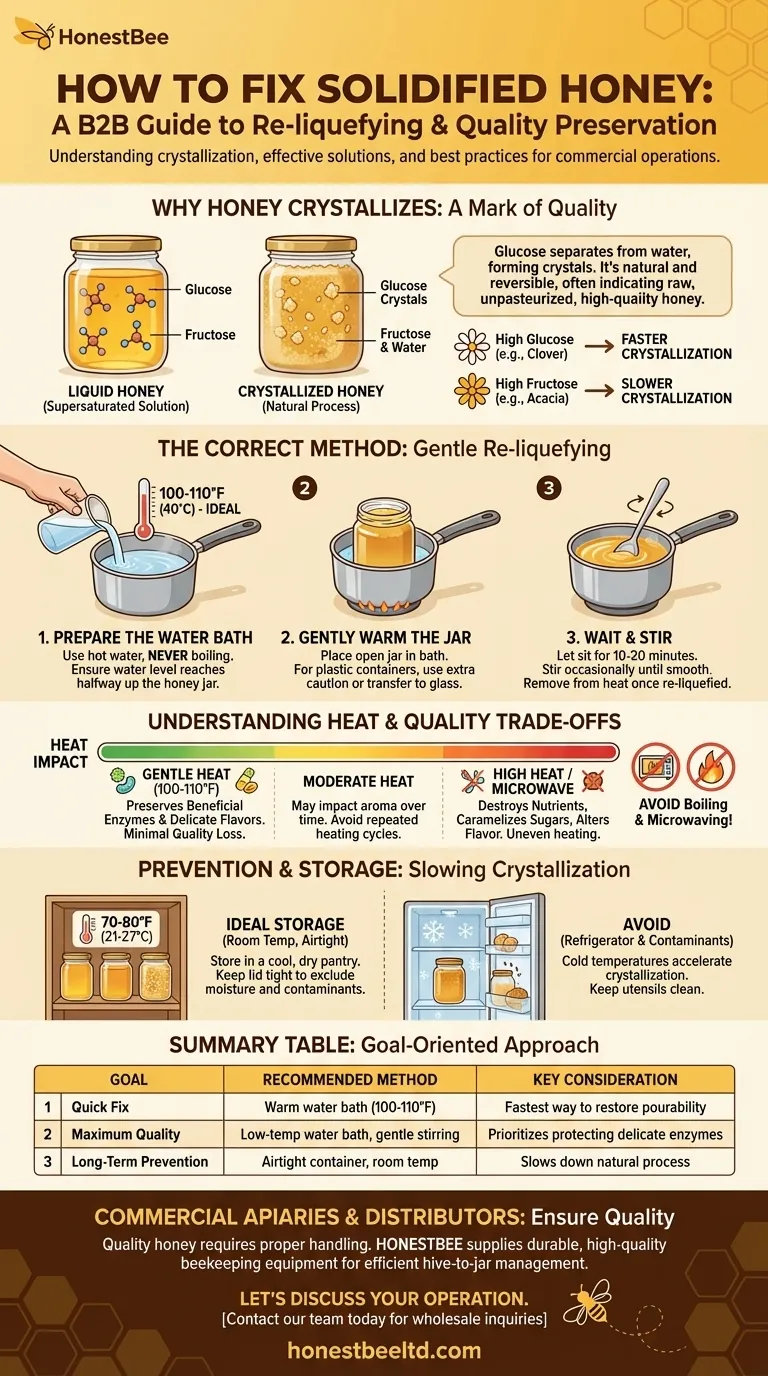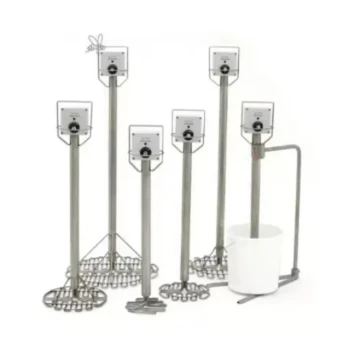The simplest way to fix solidified honey is to gently warm the jar in a pot of hot water. This process, called re-liquefying, carefully melts the natural sugar crystals that have formed without damaging the honey. The key is to use gentle, indirect heat—never boil or microwave it.
Crystallization is a natural and reversible process, not a sign of spoilage. In fact, for raw and unpasteurized honey, it's an indicator of high quality. The goal is to gently re-dissolve these crystals without overheating the honey and destroying its beneficial enzymes and delicate flavors.

Why Honey Crystallizes: A Mark of Quality
Honey is a supersaturated solution of two main sugars: glucose and fructose, dissolved in a small amount of water. Crystallization happens when the glucose separates from the water and forms tiny crystals.
The Role of Glucose and Fructose
The ratio of glucose to fructose in a honey variety determines how quickly it will crystallize.
Honeys high in glucose, like clover or lavender honey, will crystallize relatively quickly. Honeys higher in fructose, like acacia or tupelo honey, will remain liquid for much longer.
It's Natural, Not a Flaw
This process is entirely natural and does not mean the honey has gone bad. Commercially processed honey is often filtered and pasteurized at high heat specifically to prevent crystallization, but this can damage its more nuanced qualities.
The Correct Method to Re-liquefy Honey
The only safe method is the warm water bath. It provides the gentle, even heat needed to melt the crystals without "cooking" the honey.
Step 1: Prepare the Water Bath
Fill a saucepan with enough hot tap water to come halfway up the side of your honey jar. The water should be hot to the touch, but not boiling (around 100-110°F or 40°C is ideal).
Step 2: Gently Warm the Jar
Place your open jar of honey into the water bath. If the honey is in a plastic container, be especially careful that the water is not hot enough to warp the plastic. For best results with plastic, transfer the honey to a glass jar first.
Step 3: Wait and Stir
Let the jar sit for 10 to 20 minutes, or until you see the honey begin to liquefy around the edges. You can occasionally stir the honey gently with a clean, dry utensil to speed up the process. Once it is smooth and runny, remove it from the water.
Understanding the Trade-offs: Heat and Honey Quality
While re-liquefying is simple, it's important to understand the impact of heat on honey. Your goal is preservation, not just melting.
Why You Must Avoid High Heat
Boiling water or a microwave creates intense, uncontrolled heat. This will not only melt the crystals but also destroy the beneficial enzymes and vitamins present in raw honey. It also caramelizes the sugars, permanently altering the flavor and aroma.
The Problem with Microwaves
Microwaves create "hot spots" that can superheat parts of the honey while leaving other parts solid. This uneven heating quickly degrades the honey's quality and can melt or warp plastic containers.
Does Re-liquefying Reduce Quality?
If done correctly with gentle, low-temperature heat, the impact on honey's quality is minimal. However, repeatedly cycling honey between solid and liquid states can gradually degrade its delicate aromatic compounds over time.
How to Prevent Future Crystallization
You can significantly slow down the crystallization process with proper storage.
Store at Room Temperature
The ideal storage temperature for honey is in a cool, dry place like a pantry (around 70-80°F or 21-27°C). Do not store honey in the refrigerator; the cold temperatures actually accelerate glucose crystallization.
Keep It Airtight and Clean
Always keep the lid on your honey jar sealed tightly. Also, avoid introducing moisture or small food particles (like toast crumbs) into the jar. These contaminants give the glucose crystals a surface to begin forming on, speeding up solidification.
Applying This to Your Goal
Your approach depends on what you value most.
- If your primary focus is a quick fix: The warm water bath is the fastest and most effective method to get smooth, pourable honey.
- If your primary focus is preserving maximum quality: Use the lowest effective water temperature possible, even if it takes longer, and stir gently to distribute the heat.
- If your primary focus is long-term prevention: Store your honey in a sealed container in a room-temperature pantry and always use a clean utensil to serve it.
View crystallized honey not as a problem, but as proof of its authentic, unprocessed nature.
Summary Table:
| Goal | Recommended Method | Key Consideration |
|---|---|---|
| Quick Fix | Warm water bath (100-110°F / 40°C) | Fastest way to restore pourability. |
| Maximum Quality Preservation | Low-temperature water bath with gentle stirring | Prioritizes protecting delicate enzymes and flavors. |
| Long-Term Prevention | Store in airtight container at room temperature | Slows down the natural crystallization process. |
For Commercial Apiaries & Distributors: Ensure Your Honey's Quality with the Right Equipment
As a commercial beekeeper or distributor, the quality of your honey is paramount. Proper handling and storage are crucial for maintaining its premium value. HONESTBEE supplies the durable, high-quality beekeeping supplies and equipment you need to manage your honey from hive to jar efficiently.
From extraction to storage, our wholesale-focused operations provide the reliable tools that support quality honey production. Let's discuss how our equipment can benefit your operation. Contact our team today for wholesale inquiries.
Visual Guide

Related Products
- HONESTBEE Commercial Upright Honey Melter
- Heavy Duty Stainless Steel Honey Processing Machine Decrystallizing Tank
- Honey Tank Heater Drum Heating Blanket for Honey Barrel
- Double Wall Honey Heating Stirring Homogenizer Mixing Machine with Various Capacity
- Automatic Honey Filling and Filtering Machine for Beekeeping Bottle Filling
People Also Ask
- What are the methods for heating honey? Preserve Quality and Improve Workability
- What is the heat method of processing honey? Balancing Shelf Life with Natural Quality
- Why is a honey bucket warmer considered a valuable tool for honey storage? Preserve Quality & Streamline Bottling
- What are the key features to look for in a honey warming source? Preserve Honey Quality with Gentle, Even Heat
- What can make honey runny? The Science of Sugar, Water, and Temperature



















